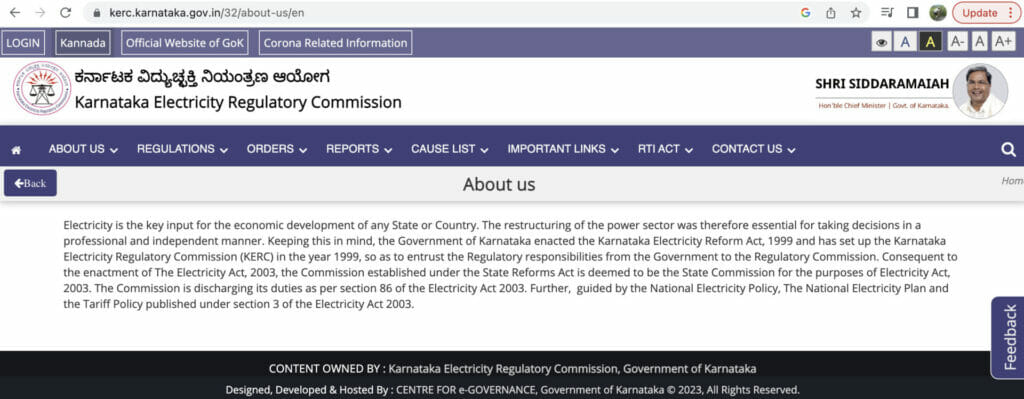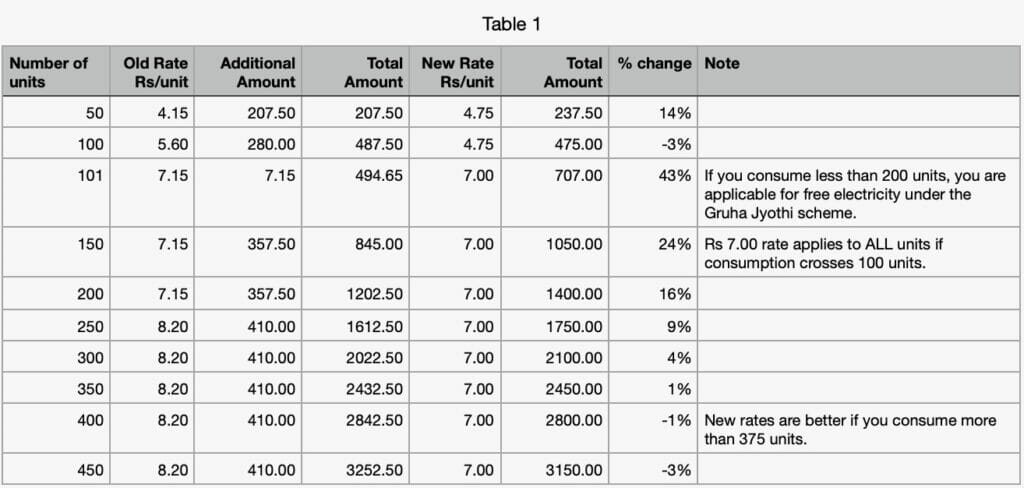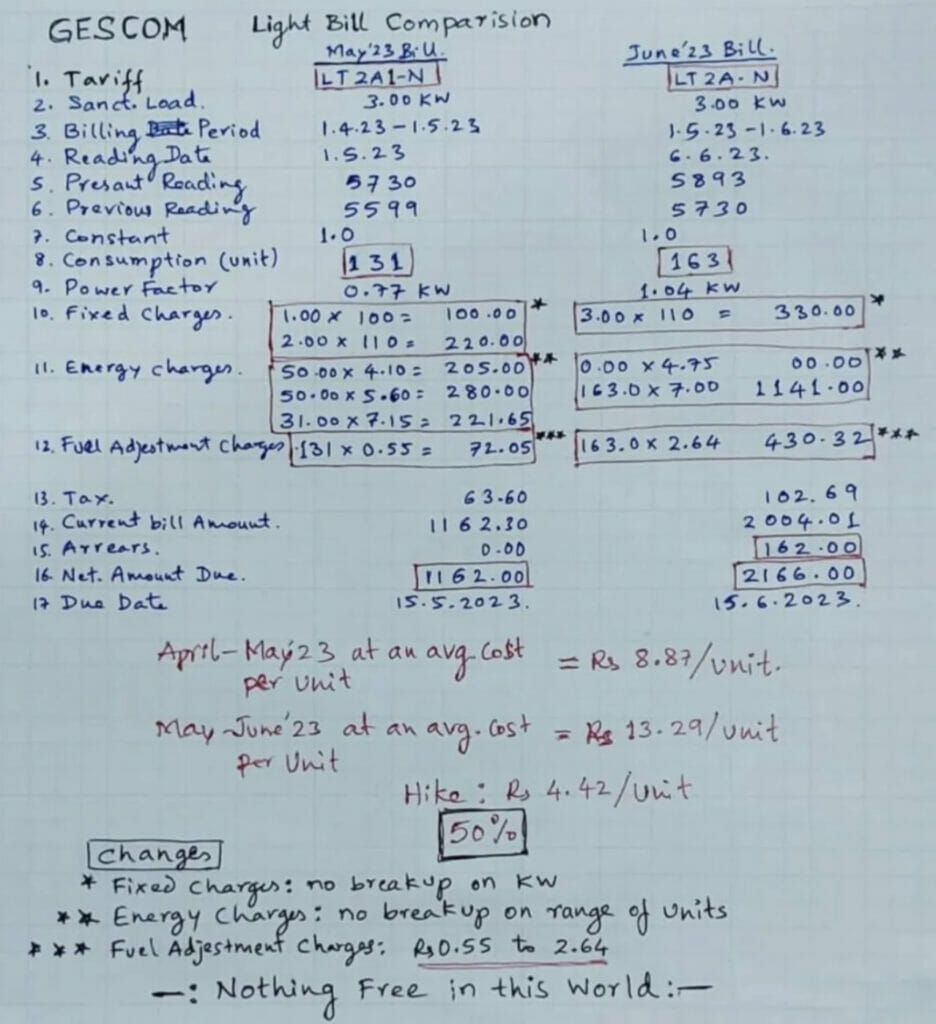Since the new Karnataka government announced the free electricity scheme, Gruha Jyoti, many news reports have talked about a large hike in electricity tariff of Rs 2.89 per unit. WhatsApp groups were forwarding messages claiming that rates went up by 50%. This piqued my curiosity, so I decided to try and understand this. Let us see how accurate they were.
First, it is important to understand the different parts of your electricity bill. It is a fairly complicated beast, consisting of many moving parts.
What goes into your monthly electricity bill?
This report from The Hindu, explains the different parts of the electricity bill. These are mainly:
- Fixed charges (FC): This has to be paid every month, whether you consume any electricity or not, and they are based on your sanctioned load or capacity. The charges are usually in Rs/KW.
- Energy charges (EC): These are what you pay for the amount of electricity you consume. It is usually charged in Rs/unit, where a unit is one kilowatt-hour.
- Fuel adjustment charges (FAC): Sometimes known as Fuel and Power Purchase Cost Adjustment (FPPCA), the FAC/FPPCA is more complicated. It compensates the electricity suppliers for variations in costs, for example, due to fuel price changes. Being an adjustment, the FAC could occasionally be negative too.
Apart from these, there may be arrears or adjustments from previous months. If your consumption increases, you may be asked to pay an additional security deposit (ASD). The ESCOMs are expected to pay interest on security deposits annually. Finally there is a 9% tax on the total bill.
One more complexity to keep in mind is that Karnataka has multiple power distribution companies (ESCOMs, such as Bengaluru’s BESCOM). The FAC/FPPCA could vary between these ESCOMs since they all buy their power from different producers.
Read more: Study: BESCOM transformers poorly maintained, can disrupt power supply
Who sets the electricity tariffs?
State governments cannot unilaterally set electricity tariffs. That job is entrusted to regulators. In Karnataka, it is the Karnataka Electricity Regulatory Commission (KERC). The KERC is a statutory authority established in 1999, and is governed by the National Electricity Policy and the Tariff Policy, published under the Electricity Act 2003.
To put it simply, the KERC receives representations from the power distributions companies (ESCOMs) for rate increases, and decides the tariffs as per its mandate. As the KERC’s tariff order for 2003 states, the factors considered while setting the tariff include average cost of supply, tariff policy (keeping tariffs low for certain categories of customers), rationalisation of tariffs, etc.

Read more: BESCOM, here’s why you shouldn’t hike electricity tariff
What was the approved change in tariffs?
Most reports did mention a tariff increase of Rs 0.70 per unit, approved by KERC, but still went on to talk about a Rs 2.89/unit hike in rates without explaining where that number came from. When I looked into this in more detail, it turns out that there were multiple changes: in the slabs, energy charges (per-unit), fixed charges, and FAC.

A Deccan Herald report explains the changes in the tariff:
“Previously, there were three billing slabs. The first 50 units were charged at Rs 4.15 per unit, the next 50 units at Rs 5.6 per unit, and beyond that, Rs 7.15 per unit was collected. However, under the new tariff system, consumers are billed Rs 4.75 per unit for the first 100 units. If consumption exceeds 100 units, they are charged a flat Rs 7 per unit.”
So where did the Rs 2.89 per unit originate? One Indian Express report came closest to explain the origin of the number Rs 2.89 per unit.
“Electricity has got costlier after the Karnataka Electricity Regulatory Commission approved electricity supply companies’ proposals that as per a May 12th tariff order, a hike of 70 paise per unit has to be levied in June. In addition to this, arrears of 70 paise per unit pertaining to April will also be added to the bills in June. Consequently, the FPPCA charge of Rs 1.49 per unit will also be levied in June and Rs 1.81 per unit is carried forward to July. Thus, there will be an overall increase in tariff for June by Rs 2.89/unit.”
So clearly Rs 2.89 per unit consists of arrears of Rs 0.70 per unit for April, and arrears of FPPCA of Rs 1.49 per unit from earlier months.
The FAC/FPPCA charges vary across the different ESCOMs, which added to the confusion. For example, this social media post claiming that rates were raised by 50% went viral, and BESCOM had to issue a statement calling it fake.
What they didn’t seem to care about was that the “fake bill” clearly mentions that it was from GESCOM (Gulbarga Electricity Supply Company Limited)! It is quite possible that GESCOM did recover FAC at rates different from BESCOM!

What is the actual rate increase?
That is a difficult question to answer, given all the complexity that is part of an electricity bill. On June 17th, we received the June bills for our apartment building, and our own bill was actually slightly less than last month’s bill. This was mainly due to a large negative arrears, which I suspect represents the annual interest paid on the security deposit. Also, BESCOM did not collect the FAC or the energy charge arrears, which may show up in next month’s bill.
To estimate the rate increase correctly, one has to remove all the arrears, which are charges related to previous months. The fuel adjustment FAC/FPPCA can get quite complicated, as this BESCOM document shows, so we can not include that either, so we are down to just the energy charges.
Looking only at the energy charges, someone who consumes 200 units per month would pay about 16% more (Rs 1,400 instead of Rs 1,202). But anyone who consumes more than 377 units would actually pay less, since they are paying a flat rate of Rs 7.00, instead of the earlier rate of Rs 8.20, for units about 200.
Once the Gruha Jyothi scheme is implemented, households consuming less than 200 units should receive a zero bill. For those consuming more than 200 units, it might be correct to say that the rate increase is in the range of 0–16%, with an average of about 10–12%.
Given all this, it is clearly false to claim that Karnataka increased electricity rates by Rs 2.89 per unit.
As we saw earlier, the Rs 2.89 per unit, if it is collected in the June bill, would include Rs 2.19 per unit of arrears and only Rs 0.70 per unit of additional energy charges.
It was irresponsible of all the media houses and individuals who kept propagating this misinformation, spreading fear and mistrust, instead of explaining things to consumers.
Who is responsible for the rate hike?
Most headlines attributed the rate hike to the new Karnataka government, and linked it to the launch of their scheme to provide free electricity to households. Clearly, this is incorrect. The Karnataka State government is only proposing to pay the bill of certain consumers (or send them a zero bill), but it does not have the authority to set the tariffs.
The first thing to understand is that the tariffs are set by a statutory authority, the KERC. Also, the tariff increase was approved on May 12th, long before the new government was in place. So, it is completely unrelated to the new government’s choices.
It is irresponsible to link this electricity tariff increase, approved before the elections, to the new government and its policies.
I am not sure KERC is the final authority on tariffs. Would they, for instance, order/ approve 200 units free to a consumer? As such, I feel, they can only make recommendations; the final decision is with the government
KERC is a useless burden comprising mostly of incompetent retired bureaucrats who always go along with ESCOM’s demands and ignore consumer’s interests without applying their minds, to keep their jobs and enjoy its perks. It should be disbanded to save consumers additional costs in paying for its operations
How can you arbitrarily charge arrears when there was no default on the customer’s side in payments? What kind of accounting is this? This is worse than gambling.
Did the regulatory authority approve free electricity upto 200 units?
KERC tariff structure table is quite wrong and misleading. If consumption exceeds 100 units, the charge is a flat Rs 7 per unit for the ENTIRE consumption, ie graded slabs no longer apply.